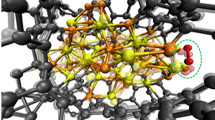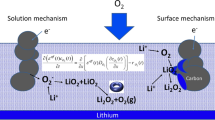Abstract
Kinetic analysis of the Li|Li+ interphase in an electrolyte based on N-metyl-N-propylpyrrolidinium bis(trifluoromethanesulfon)imide ionic liquid (MPPyrrTFSI) and lithium bis(trifluoromethanesulfon)imide salt (LiTFSI) was performed. Li|electrolyte|Li and LiC6|electrolyte|Li cells were galvanostatically charged/discharged in order to form solid electrolyte interphase (SEI) protecting layer. SEM images showed that the surface of both Li and LiC6 anodes was covered with small particles. The fitting procedure of electrochemical impedance data taken at different temperatures gave three resistances (R el, R SEI, R ct) and hence, three lnR = f(T −1) straight lines of different slopes. Specific conductivity and activation energy of the conduction process of the liquid electrolyte, were ca. σ = 2.5 mS cm−1 (at T = 25.0 °C) and \( E_{\text{el}}^{\# } \) = 15 kJ mol−1. Activation energy for the conduction process in the SEI layer was ca. 56 kJ mol−1 in the case of the metallic lithium and 62 kJ mol−1 for the graphite anode. Activation energy of the charge transfer process, \( E_{\text{ct}}^{\# } \), for Li and LiC6 anodes was 71 and 65 kJ mol−1, respectively. Analysis of literature data for different electrolytes suggests that the \( E_{\text{ct}}^{\# } \) value for Li+ reduction may be approximated by 57 ± 5 kJ mol−1. Activation energy for the diffusion processes in the graphite electrode, detected from the Warburg coefficient, was ca 74 kJ mol−1.








Similar content being viewed by others
References
Peled E (1979) The electrochemical behavior of alkali and alkaline earth metals in nonaqueous battery systems—the solid electrolyte interphase model. J Electrochem Soc 126:2047–2051
Rahner D, Machill S, Siury K (1997) Passivity of lithium in organic solvents. J Power Sour 68:69–74
Yazami R, Touzain P (1983) A reversible graphite-lithium negative electrode for electrochemical generators. J Power Sour 9:365–371
Dey A (1977) Lithium anode film and organic and inorganic electrolyte batteries. Thin Solid Films 43:131–171
Zaban A, Zinigrad E, Aurbach D (1996) Impedance spectroscopy of Li electrodes. 4. A general simple model of the Li-solution. Interphase in polar aprotic systems. J Phys Chem 100:3089–3101
Aurbach D (2000) Review of selected electrode–solution interactions which determine the performance of Li and Li ion batteries. J Power Sour 89:206–218
Edstrom K, Herstedt M, Abraham DP (2006) A new look at the solid electrolyte interphase on graphite anodes in Li-ion batteries. J Power Sour 153:380–384
Bryngelsson H, Stjerndahl M, Gustafsson T, Edstrom K (2007) How dynamic is the SEI? J Power Sour 174:970–975
Peled E, Golodnitsky D (2004) SEI on lithium. In: Balbuena PB, Wang Y (eds) Lithium-ion batteries, solid-electrolyte interphase. Imperial College Press, London, pp 16–39
Holzapfel M, Jost C, Novak P (2004) Stable cycling of graphite in an ionic liquid based electrolyte. Chem Commun 2004:2098–2099
Galinski M, Lewandowski A, Stepniak I (2006) Ionic liquids as electrolytes. Electrochim Acta 51:5567–5580
Sato T, Maruo T, Marukane S, Takagi K (2004) Ionic liquids containing carbonate solvent as electrolytes for lithium ion cell. J Power Sour 138:253–261
Zheng H, Jiang J, Abe T, Ogumi Z (2006) Electrochemical intercalation of lithium into a natural graphite anode in quaternary ammonium-based ionic liquid electrolytes. Carbon 44:203–210
Jin J, Li HH, Wei JP, Bian XK, Zhou Z, Yan J (2009) Li/LiFePO4 batteries with room temperature ionic liquid as electrolyte. Electrochem Commun 11:1500–1503
Holzapfel M, Jost C, Prodi-Schwab A, Krumeich F, Wursig A, Buqa H, Novak P (2005) Stabilisation of lithiated graphite in an electrolyte based on ionic liquids: an electrochemical and scanning electron microscopy study. Carbon 43:1488–1498
Guerfi A, Dontigny M, Charest P, Petitclerc M, Lagace P, Vijh A, Zaghib K (2010) Improved electrolytes for Li-ion batteries: mixtures of ionic liquid and organic electrolyte with enhanced safety and electrochemical performance. J Power Sour 195:845–852
Byrne N, Howlett PC, MacFarlane DR, Forsyth M (2005) The Zwitterion effect in ionic liquids: towards practical rechargeable lithium-metal batteries. Adv Mater 17:2497–2501
Lewandowski A, Świderska-Mocek A (2009) Properties of the lithium and graphite–lithium anodes in N-methyl-N-propylpyrrolidinium bis(trifluoromethanesulfonyl)imide. J Power Sources 194:502–507
Abe K, Miyoshi K, Hattori T, Ushigoe Y, Yoshitake H (2008) Functional electrolytes: synergetic effect of electrolyte additives for lithium-ion battery. J Power Sour 184:449–455
Seki S, Kobayashi Y, Miyashiro H, Ohno Y, Mita Y, Terada N, Charest P, Guerfi A, Zaghib K (2002) Compatibility of N-methyl-N-propylpyrrolidinium cation room-temperature ionic liquid electrolytes and graphite electrodes. J Phys Chem C 112:16708–16713
Aurbach D, Gamolsky K, Markovsky B, Gofer Y, Schmidt M, Heider U (2002) On the use of vinylene carbonate (VC) as an additive to electrolyte solutions for Li-ion batteries. Electrochim Acta 47:1423–1439
Fu Y, Chen C, Qiu C, Ma X (2009) Vinyl ethylene carbonate as an additive to ionic liquid electrolyte for lithium ion batteries. J Appl Electrochem 39:2597–2603
Sun XG, Dai S (2010) Electrochemical investigations of ionic liquids with vinylene carbonate for applications in rechargeable lithium ion batteries. Electrochim Acta 55:4618–4626
Lewandowski A, Biegun M, Galinski M (2012) Kinetics of Li+ reduction in 1-methyl-3-propylpiperidinium bis(trifluoromethylsulfonyl) imide room temperature ionic liquid. Electrochim Acta 63:204–208
Appetecchi GB, Scaccia S, Tizzani C, Alessandrini F, Passerini D (2006) Synthesis of hydrophobic ionic liquids for electrochemical applications. J Electrochem Soc 153: A1685–A1691
Pelled E, Golodnitsky D, Ardel G (1997) Advanced Model for Solid Electrolyte Interphase Electrodes in Liquid and Polymer Electrolytes. J Electrochem Soc 144:L208–L210
Barisci JN, Walace GG, MacFarlane DR, Baughman RH (20004) Investigation of ionic liquids as electrolytes for carbon nanotube electrodes. Electrochem Commun 6:22-27
Xu K, Lam Y, Zhang SS, Jow TR, Curtis TB (2007) Solvation Sheath of Li+ in Nonaqueous Electrolytes and Its Implication of Graphite/Electrolyte Interface Chemistry. J Phys Chem C 111:7411–7421
Xu K (2007)“Charge-Transfer” Process at Graphite/Electrolyte Interface and the Solvation Sheath Structure of Li+ in Nonaqueous Electrolytes. J Electrochem Soc 154:A162-A167
Yamada Y, Iriyama Y, Abe T, Ogumi Z (2009) Kinetics of lithium ion transfer at the interface between graphite and liquid electrolytes: effects of solvent and surface film. Langmuir 25:12766–12770
Xu K, von Cresce A, Lee U (2010) Differentiating contributions to “ion transfer” barrier from interphasial resistance and Li+ desolvation at electrolyte/graphite interface. Langmuir 26:11538–11543
Churikov AV, Volgin MA, Pridatko KI (2002) On the determination of kinetic characteristics of lithium intercalation into carbon. Electrochim Acta 47:2857–2865
Acknowledgments
Support of Grant 31-242/12 DS-PB is gratefully acknowledged.
Author information
Authors and Affiliations
Corresponding author
Rights and permissions
About this article
Cite this article
Lewandowski, A., Biegun, M., Galinski, M. et al. Kinetic analysis of Li|Li+ interphase in an ionic liquid electrolyte. J Appl Electrochem 43, 367–374 (2013). https://doi.org/10.1007/s10800-012-0515-0
Received:
Accepted:
Published:
Issue Date:
DOI: https://doi.org/10.1007/s10800-012-0515-0




